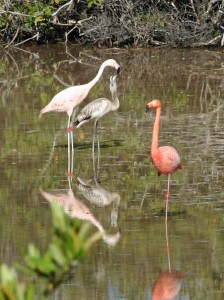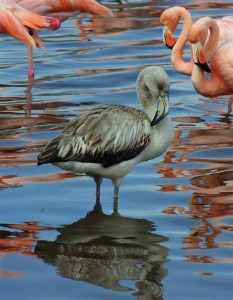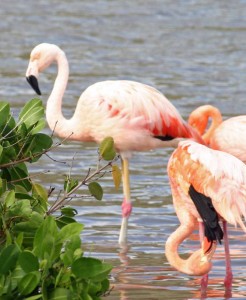Written on May 7, 2020 by Greg Estes and Thalia Grant
Update on the Covid-19 lockdown situation in Galapagos.
We have been in lockdown now since March 21, 47 days ago! Or as our neighbour, in a melancholy mood, noted last night, two full moons ago! Lockdown here means a 2 pm-5 am curfew (“toque de queda”) and a general order to stay at home (“quedate en casa”) unless absolutely necessary. When going out we must wear a face mask and remain 2 meters apart. We are allowed to shop for food twice a week, depending on the last digit of our “cedula” or identity card; for my wife and I this translates to Tuesday and Thursday. We line up outside (2 meters apart), our hands are sprayed with alcohol, we step in disinfectant, and then are allowed into the shop.
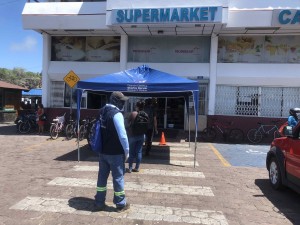
A similar procedure occurs at the open air vegetable markets. Fortunately the shops have remained well stocked because keeping the residents of the archipelago supplied with necessities from the mainland has been a priority. Fresh fruit and vegetables have been more limited with little variety, as produce no longer arrives regularly by plane. Of course a lot is produced here, in the agricultural zone on Santa Cruz, but it has been a dry year. Fortunately we received a very welcome heavy downpour of rain on Easter, which has given the farmers some hope. Cars and taxis are allowed to operate once a week, depending on the last digit of their license plate. As we live on “the other side” of the bay in Puerto Ayora, where there are no roads, the lack of traffic has not been noticeable. It has, however, been tricky finding transport (water taxis) to cross the bay to go shopping.

Tourism has stopped completely in Galapagos. The whole of the National Park is closed and so are all the visitor sites, even the local sites like the beach at Tortuga Bay. The tour boats are at anchor in the ports; here at Puerto Ayora, as well as in the Itabaca Canal between Santa Cruz and Baltra Islands, at Puerto Baquerizo Moreno (San Cristobal Island) and at Puerto Villamil (Isabela). Fishing boats are allowed to go out to fish, but must be back at port within 24 hours. It is wonderfully quiet!
Flights to and from the archipelago have ceased, except for logistical carriers bringing in medical supplies and personnel and a weekly commercial flight that arrives empty to take away people who need to travel back to the mainland. Most of the tourists stuck in Galapagos when the lockdown started were able to leave on commercial and private flights in late March. Some of the yachts, which had stopped in Galápagos on their way across the Pacific, appear to be stranded in Galápagos with nowhere to go, as they are unsure that they will be allowed into any other ports. They are also worried about how long the authorities here in Galápagos will let them stay.
The Governor of Galapagos and other Ecuadorian governmental officials are doing an excellent job of keeping everyone informed -of Covid-19 cases, of regulations during the State of Emergency, of ways to prevent the spread of the virus, of ways to keep healthy –mainly through WhatsApp. They have also been effective in keeping the spread of false news, one of the biggest potential problems, in check. Thanks to international, national and private donations we have a fully operational PCR lab in Puerto Ayora, testing kits, respirators and emergency medical isolation facilities ready to be used, just in case. We do have Covid-19 cases in Galapagos, but there is no community-spread of the virus, and only one hospitalization. Streets have been washed with disinfectant and the restriction of movement seems to be working. There is of course great anxiety about the economic impact of the virus, over 70% of the people who live here being dependent on tourism, like ourselves. There are also over 2000 Galapagos residents on the mainland who are desperately wanting to return to the archipelago. They are being brought back to the islands bit by bit in small groups, after undergoing strict social isolation and testing protocols on the mainland.
We have been spending the past 6 weeks enjoying our house and the quiet. To pass the time and alleviate anxiety we garden, bird-watch (our house overlooks a lagoon and we walk by the beach on our way to town), talk to our family by skype, do jigsaw puzzles, watch movies, read and ….repeat. For exercise we dance, skip rope work out and walk when we can. We have also been busy writing, and have just submitted three articles to Galapagos Research, the journal of the Charles Darwin Foundation, on some ornithological and historical work we conducted last year and early this year.
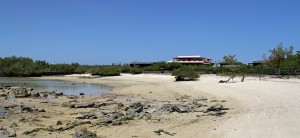
We are told that things might become less restrictive later this month, but for the next two weeks we are in a holding pattern. Officials are now using a traffic light system -yellow, orange and red- to indicate where we are in terms of restrictions. We are still in red. All non-essential businesses remain closed.
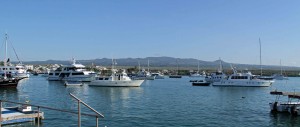
On a positive note we love how the wildlife of Galapagos seems to be thriving. The recent rain has turned the island green, the native Lantana and Croton are in full flower, and the Darwin’s finches are singing and undertaking a second bout of breeding. So are the Galapagos flycatchers. Just yesterday, as I was reclined in a lawn chair, a flycatcher landed on my nose and proceeded to tug at my hair for its nest! If only it would give me a full and much-needed haircut! In our garden we are regularly serenaded by Galapagos mockingbirds and we are hearing and seeing more and more of the elusive dark-billed cuckoos. A Galapagos snake slithered over the doorstop at the entrance to our property the other day. Yellow-crowned night herons walk across our roof at night, and a barn owl sometimes visits in the evening. Several pairs of black-necked stilts have nested in the lagoon; two successfully.
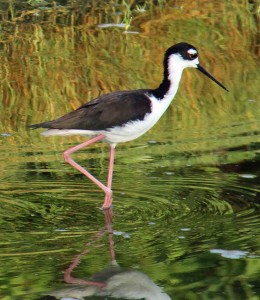
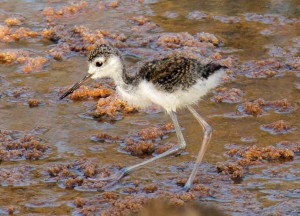
Ghost crabs, endemic lava gulls, striated herons, white-cheeked pintail ducks, and marine iguanas are reclaiming the beach. The other day, as were waiting for a taxi to cross the bay, a sea lion popped its head up out of the water and looked at us intently as if asking “Where is everyone?”
Every evening we sit up on our balcony to admire the blue-footed boobies diving in the bay and to watch (and sometimes count!) the thousands of cattle egrets that fly from their feeding grounds in the highlands, among the giant tortoises, to their night time roosts in the coastal mangroves. How we envy their freedom of movement!
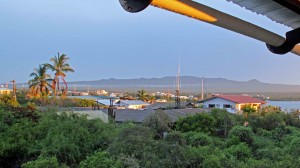
Posted on July 24, 2017 by Thalia Grant and Greg Estes
About 8 pm on the evening of April 16, 2017 Greg witnessed dozens of sharks feeding on flying fish while at anchor at Gardner Bay, Española. Greg filmed the following clip at the stern of the yacht using a Canon S120 camera and flashlight. At least two species of flying fish were identified: the ornamental flying fish Cypselurus callopterus and the whitemargin flying fish Cheilopogon spilonotopterus. The sharks (about 100 of which were congregated round the entire yacht) were silky sharks Carcharhinus falciformis. A sealion (Zalophus wollebaeki) was also spotted chasing the fish. It is not uncommon to see a few sharks swimming around yachts in Galapagos at night, as they and their prey are attracted to ship lights, but almost never in densities approaching those seen in this incredible feeding frenzy.
Posted on July 23, 2017 by Thalia Grant and Greg Estes
Marine Iguana feeding on land plants
Marine iguanas (Amblyrhynchus cristatus) feed almost exclusively on marine algae in the inter- and subtidal zones, but on rare occasion some individuals will supplement their diet with shore plants. Terrestrial feeding among marine iguanas is known mainly from North Seymour Island where several years ago a sub-population of iguanas (mostly large adults) supplemented their diet with the halophyte Batis maritima, a behaviour that kept them alive through El Niño years and other periods of severe algae shortage. In 1997 high tides swamped and killed off the island’s Batis plants, and as a result the iguanas starved to death during that (1997-1998) El Niño year (Wikelski and Wrege, 2000. Niche Expansion, Body Size, and Survival in Galapagos Marine Iguanas. Oecologia 124 (1), pp 107-115). Plant eating has also been recorded on Santa Cruz Island, where individual adult marine iguanas in Academy Bay very occasionally eat another halophyte, the common carpetweed, Sesuvium portulacastrum. We filmed this rare behavior a few days ago.
Posted on June 3, 2017 by Thalia Grant and Greg Estes
Kicker Rock is NOT named for its boot-like shape

“Kicker Rock” was dubbed by Captain James Colnett, whose visit to the Galapagos Islands on the Rattler in 1793 and 1794 “kick-started” British and American whaling in the archipelago. It has been assumed that the name “Kicker” derives from the islet’s shoe-like profile. However, historical sleuthing, conducted by Thalia Grant, has now revealed that the likeness is a coincidence; the name has a “monumentally” different origin….. Click on the link below to learn more.
http://www.darwinfoundation.org/datazone/media/journal/pdf/G79PrePub.pdf
Posted on May 21, 2017 by Thalia Grant and Greg Estes
Greg reports first known breeding attempt of Chilean flamingos in Galapagos
A pair of Chilean flamingos (Phoenicopterus chilensis) have bred in Galapagos! On April 4 2017 Greg Estes took photographs of a Chilean flamingo feeding a young one in the lagoon at Punta Cormorant on Floreana Island, and sent his observations to the Charles Darwin Foundation. Greg sighted the juvenile again on May 21. This is the first known record of Chilean flamingos breeding in Galapagos. The species has only been recorded in the islands recently: in October 2015 two adult individuals were sighted in the lagoon at Punta Cormorant by Tui De Roy, and they were registered again in July 2016 by Luis Die (http://www.darwinfoundation.org/en/news/2017/2/10/first-record-chilean-flamingo-galapagos/). This year (2017) Greg saw the pair at Punta Cormorant on three occasions: in January, April and May. It is interesting that their breeding did not coincide with that of the American flamingo (Phoenicopterus ruber glyphorhynchus) which is the resident flamingo species in Galapagos; although American flamingos were present in the lagoon earlier this year they did not start breeding until May. The Chilean flamingo’s nest was not seen, and was probably tucked out of sight from the visiting trail. Needless to say, we will want to know if the juvenile survives to adulthood and if the Chilean flamingo pair stay in the islands to breed again. In the Bird list for the Galapagos Islands the Chilean flamingo has been placed in the “vagrant” category, i.e. a species that rarely or occasionally arrives in Galapagos on its own, but that does not come to reproduce. Their classification may need to be amended.
Greg’s photograph above was taken on April 4 and shows the Chilean flamingo feeding the juvenile on the left while an American flamingo stands on one foot on the right. Chilean flamingos differ from American flamingos in having yellowish grey legs with bright pink “knees”, paler plumage and more extensive black on the bill. Greg’s photographs below are of the juvenile (left) and adult (right) Chilean flamingo and were taken on May 21, 2017.
Discovering a subfossil of Darwin’s lost land iguana in the Galapagos Islands
Posted on February 12, 2012 – DARWIN DAY – HAPPY BIRTHDAY CHARLES DARWIN
It has been 177 years since Charles Darwin’s historic visit to the Galapagos Islands. Considering the paramount importance of this visit in his conversion to evolution it may come as a surprise that Darwin spent only 19 days on shore and visited only four islands. He spent about half of this time on just one island; James now known as Santiago, where he found land iguanas in abundance. “I cannot give a more forcible proof of their numbers, than by stating, that when we were left at James Island, we could not for some time find a spot free from their burrows, on which to pitch our tent.”
Darwin was not the first Galapagos visitor to record seeing land iguanas on James Island – James Colnett (1793-94) and David Porter (1813) preceded him – but as far as it is known he was the last. When scientist Louis Agassiz visited the island in 1872 he could not find a single individual in James Bay. (For more on Darwin and Galapagos see Darwin in Galapagos; Footsteps to a New World by K. Thalia Grant & Gregory B. Estes)
Today land iguanas are gone on James Island due to human impact. Darwin said, “The meat of these animals when cooked is white, and by those whose stomachs rise above all prejudices, it is relished as very good food.” Other causes of their disappearance have been habitat destruction and predation from introduced mammals (goats, pigs, rats and donkeys). The good news is that most introduced mammals are now gone on James through the efforts of the Galapagos National Park Service. The habitat is being restored and there are discussions on reintroducing land iguanas to the island.
In 1996, using Darwin’s original manuscripts from the Darwin Archive in the University of Cambridge we retraced Darwin’s steps in the islands and discovered a subfossil tortoise egg at Buccaneer Cove on James Island. There are no historical records of tortoises from this part of the island although early mariners in search of water and food frequented Buccaneer Cove.
In 2011 we returned to Buccaneer Cove to search for more subfossil eggs. Over a period of several hours we were amazed to find over forty nests each with about four subfossil eggs indicating that this was a principal nesting ground for tortoises. This may explain why this was such a popular spot for early mariners. It was while searching for these eggs that we made an even more astonishing discovery; the remains of one of the lost James Island land iguanas.
When we first found the pelvis protruding out of the volcanic ash we suspected it was land iguana. Our excitement with this find was that, if proven to be land iguana, this would represent the first confirmed specimen of land iguana from James Island. The only other known specimens of land iguana from James Island are from HMS Beagle’s visit, one from Darwin’s collection and one from captain FitzRoy’s collection. There is however some uncertainty as to the provenance of these specimens as Darwin and FitzRoy first mentioned seeing land iguanas on Albemarle (Isabela) Island. In his diary for October 1, 1835 after visiting Albemarle Island Darwin said, “They are hideous animals; but are considered good food: this day forty were collected.”
We are pleased to announce today on Darwin’s birthday that it has been confirmed that our specimen is indeed a land iguana. We hope that this specimen may be used to help determine this land iguana’s phylogenetic relationship with others found in the islands and contribute to studies to find James Island’s closest relative which may factor in restoring James Island’s ecosystem.
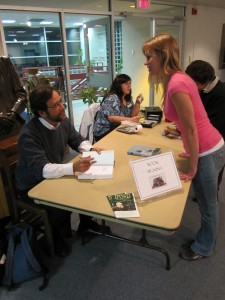

Book signing at Casper, Wyoming on November 14, 2011
Posted on November 23, 2011
Greg was at Casper College on Monday, Nov. 14 to speak on “Darwin and Galapagos.” The presentation followed the unveiling of the U.S. National Library of Medicine National Institutes of Health Darwin exhibit: Rewriting the Book of Nature: Charles Darwin and the Rise of Evolutionary Theory. Greg signed copies of Darwin in Galapagos: Footsteps to a New World before his presentation in the Roberts Commons Ballroom at Casper College.
Posted by K. Thalia Grant
midday, March 12, 2011
Galapagos Tsunami 2011 update
This tsunami was considerably more intense than the tsunami experienced in Galapagos in 2010. More reports of damage in Puerto Ayora are coming in. The Charles Darwin Research Station suffered severe damage to the labs of the Biomar building. Scuba Iguana, Red Mangrove Hotel, Banco Pacifico, Hotel Finch Bay, and the Parque San Franciso have also experienced significant damage to their lower floors, with some lobbies being filled with over a meter of water. The board walk behind Playa Alemanes was completely ripped out. A lot of debris covers the streets and properties close to the shore but clean up efforts have begun. Electicity has been returned to at least some parts of Puerto Ayora.
Posted by K. Thalia Grant
morning, March 12, 2011
Tsunami generated by massive 8.9 earthquake in Japan causes damage in Galapagos
Yesterday, at 6:38 pm local time, a tsunami wave that was generated by an earthquake off the coast of Japan, hit the town of Puerto Ayora, Santa Cruz Island. The wave was 5.8 feet (1.8 meters). Early reports indicated no damage to the coastal areas of Galapagos, however the reports were issued at the time the wave was anticipated (5:38 pm), which was before it actually struck. The tsunami arrived one hour later, at high tide, and caused damage to some buildings close to the shore. Some hotels, shops, restaurants , houses and office buildings experienced flooding (up to shoulder height in some cases), broken windows and some structural damage. No one was hurt as people had been evacuated to the highlands of Santa Cruz hours earlier. The electricity to Puerto Ayora had also been shut off as a precaution. All boats had left the harbors and bays of Galapagos, and visiting sites were closed down for the day.
Greg, reporting from a tour yacht off Seymour Island, said that all afternoon visits had been cancelled well in advance of the wave, and that all boats were safely off shore. Nobody on board could feel the wave. The wave that hit Baltra Island was smaller; 2.7 feet (0.8 meters).
Flights in and out of Galapagos were cancelled yesterday but have resumed today. Tourism activities are back to normal, although power remains off in Puerto Ayora.
There have been reports of damage to the water front of Puerto Baquerizo Moreno on San Cristobal Island.
I shall be updating this blog as I receive more information.
Darwin’s birthday celebrations at the Vancouver Beaty Biodiversity Museum

Posted on February 12, 2011
Check out this Princeton Darwin Day blog for an interview with Thalia Grant and Greg Estes about their research on Darwin in Galapagos.
Anyone interested in booking a tour with us please click on Greg’s trips Page or contact us at [email protected].
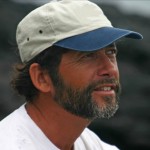
DECEMBER
A great time for for observing marine iguanas and land iguanas.
Posted on December 23, 2010 by Greg Estes
Marine Iguanas
Marine iguanas are coming into the mating season. Males are displaying and can be seen fighting over territories and access to females. Good places to observe this behaviour include Punta Espinosa (Fernandina Island), Puerto Egas (Santiago Island) and Punta Suarez (Española Island). In Puerto Ayora (Santa Cruz Island) big male iguanas can be seen swimming across Academy Bay searching for territories. Marine iguanas are doing particularly well this year with the Niña conditions (see Island Update). There is plenty of food available. Marine iguanas are especially fond of Ulva, a marine alga often referred to as sea lettuce. Normally the sea lettuce forms a short growing matt of seaweed on the intertidal lava but this year, with the cool nutrient rich waters in the Galapagos, one can see long green fleshy fronds along the shoreline at low tide. From December through February the Española iguanas are particularly colourful when they take on the Christmas colors of red and green. It is not clear why the iguanas are red on Española. One explanation is that the color is related to the iguana’s diet of red algae which is abundant around Española.
Land Iguanas
December and January is a good time for land iguanas. The Opuntia prickly pear cactus is coming into flower and this is one of the land iguana’s favourite foods. They also feed on the fruits and pads of the cactus. Land iguanas generally don’t like eating cactus spines. Using their front feet they can be seen removing the spines from the pads and fruits before ingesting the cactus. A good place to observe this behaviour is South Plaza Island. During the rainy season which begins in January the island of South Plaza starts to change color. The red succulent ground cover called Sesuvium begins to change from red to green and the Portulaca comes into leaf and flower. The land iguanas have a preference for yellow as they feed on the yellow flowers of Opuntia, Portulaca and Cordia. I have seen people wearing yellow socks or shoelaces being followed down the trail by land iguanas on South Plaza. A good place to observe land iguanas feeding on the yellow Cordia is Urvina Bay on Isabela Island. The iguanas don’t just feed on the flowers of the Cordia but also like the sticky white berries. They also like the apple-like fruit of Manzanillo which is poisonous to humans. Land iguanas may have a tough time this year due to the dry conditions associated with La Niña (see Island Update). A drought is expected for at least the next few months. As a result the land plants which the land iguanas depend on may be scarce. Yesterday, December 22, 2010, while visiting North Seymour Island I observed land iguanas feeding on seaside heliotrope and saltbush.
Hybrids
South Plaza is one place in the islands where hybrid land/marine iguanas can be observed. It is somewhat surprising to come across this hybrid as the land iguana and marine iguana are not just distinct species but also different genera (the genus of land iguana is Conolophus and the genus of marine iguana is Amblyrhynchus). Both of these genera are endemic found only in the Galapagos Islands. The first time I became aware of the hybrids was back in the 1980’s when I observed a male marine iguana mating with a female iguana. I thought I had made a discovery until I talked to a biologist who had researched these animals and told me that hybrids do exist on the island. The reason they are so rare is that there are few places in the Galapagos where the territories and mating seasons of the land and marine iguanas overlap. If you visit South Plaza keep a look out for a hybrid. They look intermediate between the land iguana and marine iguana with distinctive bars running down the sides of their bodies.
Check out our Blog Archive by Greg Estes & Thalia Grant

